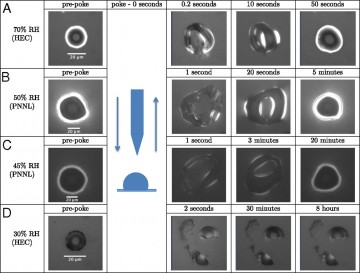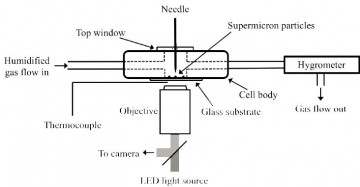The viscosity of aerosol particles is a fundamental property that is currently poorly quantified. However, information on the viscosity of these particles is required for accurate predictions of particle growth, mass and removal, all of which are closely connected to air quality and climate predictions. To quantify the viscosities of aerosol particles, we developed two new techniques, namely a bead mobility technique and a poke-flow technique combined with fluid simulations. Using these techniques, we determine the viscosities of aerosol particles as a function of relative humidity. Moreover, we apply this new data to predictions of air quality, visibility, and climate.
Determining the viscosity of aerosol particles is challenging since the viscosities can range from 10-2 to 1012 Pa·s as relative humidity changes. In addition, the amount of aerosol particles that can be collected in the atmosphere or environmental chambers is only a few milligrams. Currently only a few methods exist for determining viscosities of aerosol particles. We developed two such methods:
Bead-mobility technique
Aerosol particles consisting of 20 – 50 µm in diameter are deposited on a hydrophobic substrate. Insoluble melamine beads (~1 µm) are then incorporated into the supermicron particles. The hydrophobic substrate with the particles is then placed inside a flow-cell with relative humidity control. A continuous flow of N2/H2O gas is passed over the supermicron particles, leading to a shear stress on the surface of the particles and internal circulation of beads within the particles. We observe the velocity of the beads in the particles using a light-transmitting microscope. The bead velocity is then converted to viscosity using a calibration curve.
Poke-flow technique combined with fluid simulations
Supermicron particles suspended on a hydrophobic substrate are placed inside a flow-cell with relative humidity control. The flow-cell is similar to the one used for the bead-mobility technique except it contains a small hole on the top of the flow-cell through which a sharp needle can be inserted. The needle is first positioned over the top of a particle and then moved down to poke the particle. The geometrical changes during and after poking a particle are recorded using a reflectance optical microscope equipped with a CCD camera. From the geometrical changes, we determine the closure time of the hole and then convert the closure time to viscosity using simulations of fluid flow.
Movie of particle being poked at 70% RH. / at 30% RH.
(see details in our PNAS publication)


